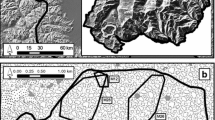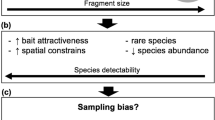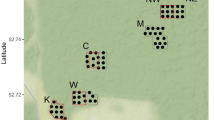Abstract
Estimating the size of ungulate populations dwelling forested habitats is technically difficult and expensive. In particular, population assessment via conventional distance sampling (CDS) at landscape scales is challenging and often discarded for its high costs. The development of a framework for its methodological optimization is mandatory. To tackle this issue, we used survey simulations. For arbitrary-distributed populations, we compared the following: (i) systematic random transect allocation, (ii) random selection of footpaths, and (iii) two-stage sampling selection of footpaths (2, 5, 10 blocks). The performance of two-stage sampling and random footpath selection estimators was similar. Then, we applied previous results to estimate the size of a red deer (Cervus elaphus) population in the Italian Apennines. Using data from a pilot survey, we estimated density via CDS and density surface modeling (DSM), and we quantified survey costs per unit effort. Considering our deer distribution, we finally simulated and evaluated the cost-effectiveness of the abovementioned designs for a range of realistic efforts (25–65 transects). CDS produced a negatively biased and less precise estimate than the corresponding DSM. For an effort of 65 transects, design (ii) estimates were unbiased (coefficient of variation = 0.31), while design (iii) provided negatively biased estimates (coefficient of variation = 0.27). Two-stage sampling designs with few blocks were less expensive than other designs in attaining the same level of precision, and they emerged as a cost-effective survey design. Our simulation approach thus provided managers a readily available tool to improve the estimate of ungulate abundances at a landscape scale.







Similar content being viewed by others
References
Baddeley A, Turner R (2005) spatstat: an R package for analyzing spatial point patterns. J Stat Softw 12:1–42
Binzenhöfer B, Schröder B, Strauss B, Biedermann R, Settele J (2005) Habitat models and habitat connectivity analysis for butterflies and burnet moths—the example of Zygaena carniolica and Coenonympha arcania. Biol Conserv 126:247–259. doi:10.1016/j.biocon.2005.05.009
Borchers DL, Buckland ST, Zucchini W (2002) Estimating animal abundance. Closed populations. Springer-V, Berlin
Buckland ST, Anderson DR, Burnham KP, Laake JL, Borchers DL, Thomas L (2001) Introduction to distance sampling: estimating abundance of biological populations. Oxford University Press, Oxford
Buckland ST, Anderson DR, Burnham KP, Laake JL, Borchers DL, Thomas L (2004) Advanced distance sampling. Estimating abundance of animal populations. Oxford University Press, Oxford
Casella G (2008) Statistical design. Springer, New York. doi:10.1007/978-0-387-75965-4
CREEM (2007) Primer for density surface modelling. Density Surface Modelling Workshop, 23-25 August 2007. Research Unit for Wildlife Population Assessment, University of St. Andrews
Elphick CS (2008) How you count counts: the importance of methods research in applied ecology. J Appl Ecol 45:1313–1320. doi:10.1111/j.1365-2664.2008.01545.x
ESRI (1998) ArcView GIS. Environmental Systems Research Institute Inc., Redlands
Fewster (2011) Variance estimation for systematic designs in spatial surveys. Biometrics 67:1518–1531
Fewster RM, Laake JL, Buckland ST (2005) Line transect sampling in small and large regions. Biometrics 61:856–861
Fewster RM, Southwell C, Borchers DL, Buckland ST, Pople AR (2008) The influence of animal mobility on the assumption of uniform distances in aerial line-transect surveys. Wildl Res 35:275–288
Focardi S, De Marinis A, Rizzotto M, Pucci A (2001) Comparative evaluation of thermal infrared imaging and spotlighting to survey wildlife. Wildl Soc Bull 29:133–139
Focardi S, Franzetti B, Ronchi F (2013) Nocturnal distance sampling of a Mediterranean population of fallow deer is consistent with population projections. Wildl Res 40:437–446. doi:10.1071/WR12218
Forcada J, Notarbartolo di Sciara G, Fabbri F (1995) Abundance of fin whales and striped dolphins summering in the Corso-Ligurian Basin. Mammalia 59:127–140
Franceschi S, Nelli L, Pisani C, Franzoi A, Fattorini L, Meriggi A et al (2014) A Monte Carlo appraisal of plot and distance sampling for surveys of black grouse and rock ptarmigan populations in Alpine protected areas. J Wildl Manage 78(2):359–368
Franzetti B, Focardi S (2006) La stima di popolazione di ungulati mediante distance sampling e termocamera a infrarossi. Doc. Tec. 26. Min. Politiche Agricole, Alimentari e Forestali - Ist. Naz. Fauna Selvatica, Ozzano Emilia (BO), pp 1–88
Franzetti B, Ronchi F, Marini F, Scacco M, Calmanti R, Calabrese A, Aragno P, Montanaro P, Focardi S (2012) Nocturnal line transect sampling of wild boar (Sus scrofa) in a Mediterranean forest: long-term comparison with capture–mark–resight population estimates. Eur J Wildl Res 58:385–402. doi:10.1007/s10344-011-0587-x
Gerrodette T (1987) A power analysis for detecting trends. Ecology 68:1364–1372
Gibbs JP, Droege S, Eagle P (1998) Monitoring populations of plants and animals. Bioscience 48:935–940. doi:10.2307/1313297
Gill RMA, Thomas ML, Stocker D (1997) The use of portable thermal imaging for estimating deer population density in forest habitats. J Appl Ecol 34:1273–1286
Gómez de Segura A, Crespo EA, Pedraza SN, Hammond PS, Raga JA (2006) Abundance of small cetaceans in waters of the central Spanish Mediterranean. Mar Biol 150:149–160. doi:10.1007/s00227-006-0334-0
Gómez de Segura A, Hammond P, Cañadas A, Raga J (2007) Comparing cetacean abundance estimates derived from spatial models and design-based line transect methods. Mar Ecol Prog Ser 329:289–299. doi:10.3354/meps329289
GRASS Development Team (2008) Geographic resources analysis support system (GRASS) Software. Open source geospatial foundation project. http://grass.osgeo.org
Harihar A, Pandav B, MacMillan DC (2014) Identifying realistic recovery targets and conservation actions for tigers in a human-dominated landscape using spatially explicit densities of wild prey and their determinants. Diversity Distrib 1-12. doi:10.1111/ddi.12174
Hastie TJ, Tibshirani RJ (1990) Generalized additive models. CRC Press, Boca Raton
Hedley SL, Buckland ST (2004) Spatial models for line transect sampling. J Agric Biol Environ Stat 9:181–199. doi:10.1198/1085711043578
Herr H, Scheidat M, Lehnert K, Siebert U (2009) Seals at sea: modelling seal distribution in the German bight based on aerial survey data. Mar Biol 156:811–820. doi:10.1007/s00227-008-1105-x
Jenkins KJ, Manly BFJ (2008) A double-observer method for reducing bias in faecal pellet surveys of forest ungulates. J Appl Ecol 45:1339–1348. doi:10.1111/j.1365-2664.2008.01512.x
Laake JL, Borchers DL, Thomas L, Miller D, Bishop J (2012) mrds: Mark-Recapture Distance Sampling (mrds). R package version 2.0.5. http://CRAN.R-project.org/package=mrds
Lyons JE, Runge MC, Laskowski HP, Kendall WL (2008) Monitoring in the context of structured decision-making and adaptive management. J Wildl Manage 72:1683–1692. doi:10.2193/2008-141
Marini F, Franzetti B, Calabrese A, Cappellini S, Focardi S (2009) Response to human presence during nocturnal line transect surveys in fallow deer (Dama dama) and wild boar (Sus scrofa). Eur J Wildl Res 55:107–115. doi:10.1007/s10344-008-0222-7
Marques TA, Buckland ST, Bispo R, Howland B (2013) Accounting for animal density gradients using independent information in distance sampling surveys. JISS 22:67–80
Matern B (1986) Spatial variation. Lecture notes in statistics. Springer, New York
Miller DL, Burt ML, Rextad EA, Thomas L (2013) Spatial models for distance sampling data: recent developments and future directions. Meth Ecol Evol 4:1001–1010. doi:10.1111/2041-210X.12105
Morellet N, Champely S, Gaillard J, Ballon P, Boscardin Y (2001) The browsing index : new tool uses browsing pressure to monitor deer populations. Wildl Soc Bull 29:1243–1252
Pollard JH, Buckland ST (2004) Adaptive distance sampling surveys. In: Buckland ST, Anderson DR, Burnham KP et al (eds) Advanced distance sampling: estimating the abundance of biological populations. Oxford University Press, Oxford, pp 229–259
Pollock KH, Nichols JD, Simons TR et al (2002) Large scale wildlife monitoring studies: statistical methods for design and analysis. Environmetrics 13:105–119. doi:10.1002/env.514
R Core Team (2013) R: a language and environment for statistical computing. R Foundation for Statistical Computing, Vienna. http://www.R-project.org/
Seber GAF (1982) The estimation of animal abundance and related parameters, 2nd ed. Griffin, London. Also reprinted in paperback by Blackburn Press, Caldwell, NJ (2002)
Skalski JR, Ryding KE, Millspaugh J (2005) Wildlife demography: analysis of sex, age, and count data. Elsevier Academic Press, San Diego
Strindberg S, Buckland ST, Thomas L (2004) Design of distance sampling surveys and Geographic Information Systems. In: Buckland ST, Anderson DR, Burnham KP et al (eds) Advanced distance sampling: estimating the abundance of biological populations. Oxford University Press, Oxford, pp 190–228
Taylor BL, Gerrodette T (1993) The uses of statistical power in conservation biology: the vaquita and northern spotted owl. Conserv Biol 7:489–500. doi:10.1046/j.1523-1739.1993.07030489.x
Thomas L, Buckland ST, Burnham KP, Anderson DR, Laake JL, Borchers DL, Strindberg S (2002) Distance sampling. Encycl Environmetrics. doi:10.1002/9780470057339.vad033.pub2
Thomas L, Buckland ST, Rexstad E, Laake JL, Strindberg S, Hedley SL, Bishop JRB, Marques TA, Burnham KP (2010) Distance software: design and analysis of distance sampling surveys for estimating population size. J Appl Ecol 47:5–14. doi:10.1111/j.1365-2664.2009.01737.x
Ward AI, White PCL, Critchley CH (2004) Roe deer Capreolus capreolus behaviour affects density estimates from distance sampling surveys. Mamm Rev 34:315–319. doi:10.1111/j.1365-2907.2004.00046.x
Winiarski KJ, Burt ML, Rexstad E, Miller DL, Trocki CL, Paton PWC, McWilliams SR (2014) Integrating aerial and ship surveys of marine birds into a combined density surface model: a case study of wintering common loons. Condor 116:149–161
Wood SN (2006) Generalized additive models: an introduction with R. CRC Press, Boca Raton
Acknowledgments
Thanks are due to A. Gennai, Foreste Casentinesi Natural Park, for the logistic support during field activities, and to O. Friard, University of Turin, for his informatic support. Two anonymous referees provided very relevant comments to the manuscript.
Author information
Authors and Affiliations
Corresponding author
Additional information
Communicated by P. Acevedo
Rights and permissions
About this article
Cite this article
La Morgia, V., Calmanti, R., Calabrese, A. et al. Cost-effective nocturnal distance sampling for landscape monitoring of ungulate populations. Eur J Wildl Res 61, 285–298 (2015). https://doi.org/10.1007/s10344-014-0898-9
Received:
Revised:
Accepted:
Published:
Issue Date:
DOI: https://doi.org/10.1007/s10344-014-0898-9




